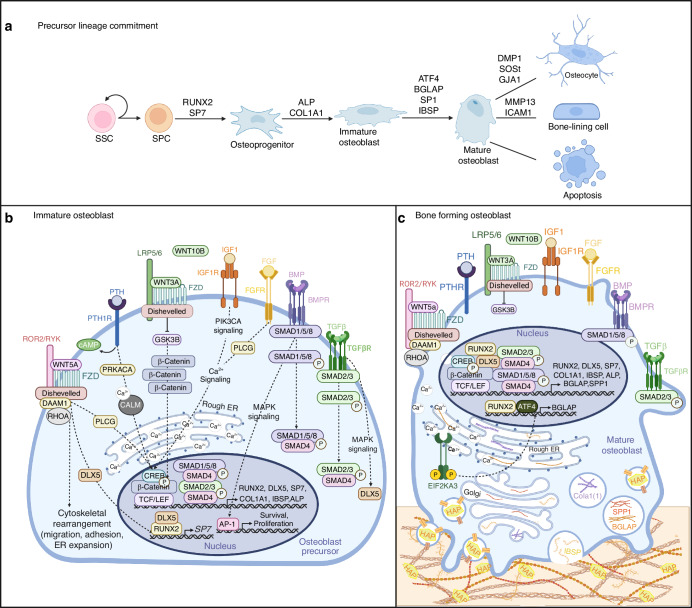Fig. 3.
Signaling cascades during osteoblast differentiation. a Stepwise changes in gene expression throughout osteoblast lineage commitment and differentiation. b Multiple signaling cascades mediate the continued differentiation of immature osteoblast cells. TGFβ binds TGFβR and mediates RUNX2 and SP7 expression via induction of SMAD2/3 and SMAD4 transcriptional activation, and MAPK-mediated induction of DLX5. BMPs mediate precursor survival and proliferation via MAPK activation of AP-1 and promote osteoblast-specific gene expression via SMAD1/5/8 interactions with SMAD4. Canonical WNT signaling is activated by WNT3A or WNT10B binding FZD receptor allowing for binding to co-receptor LRP5/6. Binding inhibits GSK3B kinase activity, allowing for β-catenin to translocate to the nucleus where it interacts with TCF/LEF transcription factors to promote RUNX2 expression. Non-canonical WNT signaling is mediated by WNT5A binding FZD and interacting with co-receptor ROR2/RYK. Adaptor protein disheveled activates DAAM1 and RHOA mediating precursor migration, adhesion and ER expansion while also promoting DLX5-mediated induction of SP7 via MAPK signaling. PTH binding to PTH1R promotes production of cAMP, activating PRKACA, inducing calcium oscillation and activating transcription factor CREB to promote osteoblast-specific gene expression. Binding of growth factors IGF1 and FGF to cognate receptors activate PIK3CA signaling to induce PLCG2, further promoting calcium signaling and CREB mediated osteoblast gene expression. c Mature osteoblasts continue to promote osteoblast-specific gene expression via BMP, TGFβ, WNT, PTH, and growth factor signaling. RUNX2 and EIF2AK3 activation mediate induction of ATF4 which promotes expression of BGLAP. Mature osteoblasts begin to secrete matrix proteins such as BGLAP, SP1, IBSP, and COL1A1 to facilitate new bone formation, and secrete vesicles containing HAP to promote matrix maturation. (Abbreviations: SSC skeletal stem cell, SPC skeletal progenitor cell, RUNX2 runt-related transcription factor-2, SP7 Sp7 transcription factor, DMP1 dentin matrix acidic phosphoprotein 1, SOST sclerostin, GJA1 gap junction protein alpha 1, MMP13 matrix metallopeptidase 13, ICAM1 intracellular adhesion molecule 1, TGFβ transforming growth factor β, TGFβR TGFβ receptor, MAPK mitogen-activated protein kinase, DLX5 distal-less homeobox 5, BMP bone morphogenic protein, BMPR BMP receptor, AP-1 activator protein 1, LRP5/6 low-density lipoprotein receptor-related protein 5 or 6, FZD frizzled, TCF/LEF T cell factor/lymphoid enhancer factor, GSK3B glycogen synthase kinase 3 beta, FGF fibroblast growth factor, FGFR FGF receptor, IGF1 insulin-like growth factor 1, IGF1R IGF1 receptor, PIK3CA phosphatidylinositol-4,5-bisphosphate 3-kinase catalytic subunit alpha, PLCG phospholipase C gamma, PTH parathyroid hormone, PTH1R PTH1 receptor, PRKACA protein kinase cAMP-activated catalytic subunit alpha, CREB cAMP-response element binding protein, CALM calmodulin, ROR2/RYK receptor tyrosine kinase of the ROR-2 and Ryk families, DAAM1 disheveled associated activator of morphogenesis 1, EIF2AK3 eukaryotic initiation factor 2 alpha kinase 3, ATF4 activating transcription factor 4, BGLAP bone gamma-carboxyglutamate protein, SP1 secreted phosphoprotein 1, IBSP integrin binding sialoprotein, COL1A1 collagen type 1 alpha 1 chain, HAP hydroxyapatite)

